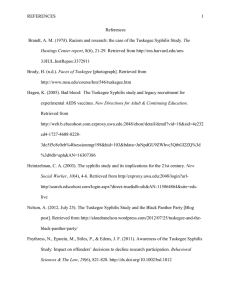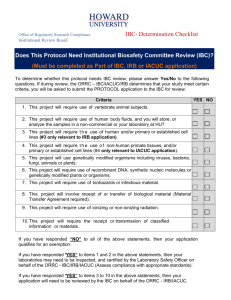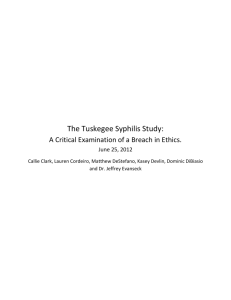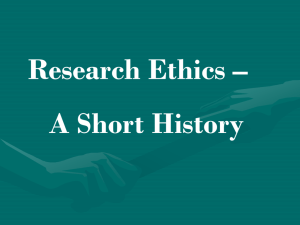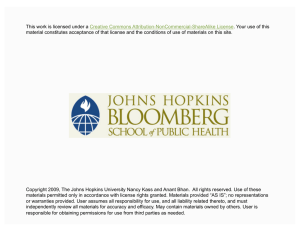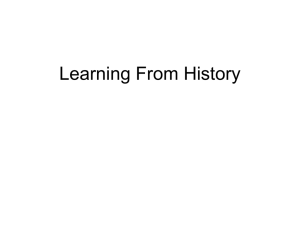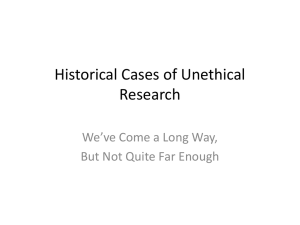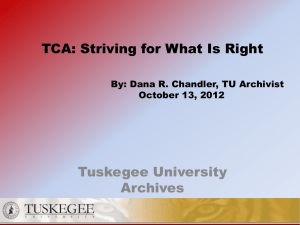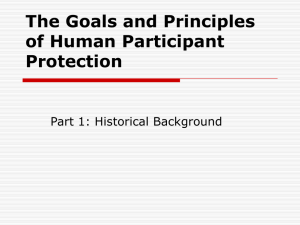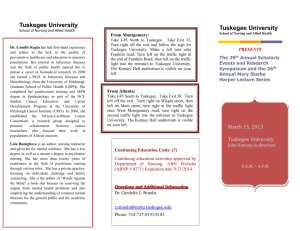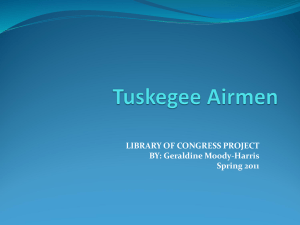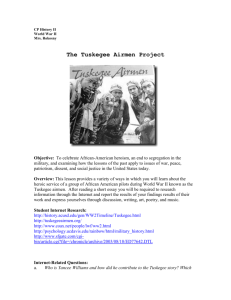Slides - College of Charleston
advertisement
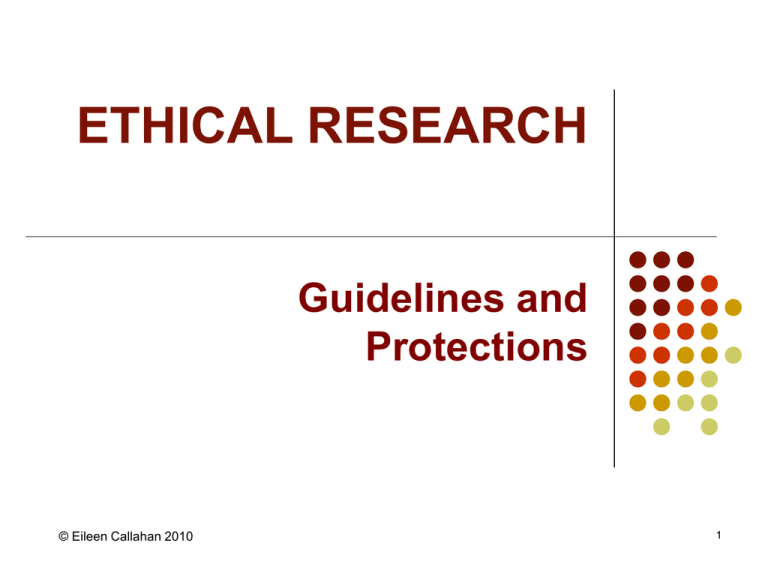
ETHICAL RESEARCH Guidelines and Protections © Eileen Callahan 2010 1 Why is it important? Whose responsibility is it? 2 Shared Values Honesty Accuracy Efficiency Objectivity - Conveying information truthfully and honoring commitments - Reporting findings precisely and taking care to avoid errors - Using resources wisely and avoiding waste - Letting the facts speak for themselves and avoiding improper bias Steneck, Nicholas H., ORI Introduction to the Responsible Conduct of Research, DHHS, 2007 3 Rules Professional Ethics Government Regulation Institutional Policies Personal Responsibility 4 Responsible Conduct of Research (RCR) Ten Key Areas 1. Data Acquisition, Management, Sharing and Ownership 2. Conflicts of Interest and Commitment 3. Publication Practices and Responsible Authorship 4. Mentor/Trainee Responsibilities 5. Peer Review 6. Collaborative Research 7. Research with Human Participants 8. Research with Animal Subjects 9. Research Misconduct 10. Fiscal Responsibility and Stewardship of Resources 5 Federal Agencies ORI (Office of Research Integrity) OBA (Office of Biotechnology Activities) USDA – APHIS (Animal and Plant Health Inspection Service) OLAW (Office of Laboratory Animal Welfare) OHRP (Office for Human Research Protections) 6 Research Compliance at the College of Charleston Institutional Animal Care and Use Committee (IRB) Institutional Review Board for the Protection of Human Research Participants (IACUC) Institutional Biosafety Committee (IBC) These committees assure compliance with regulations concerning research through Institutional policies Standard procedures Review of research projects Reporting to government regulatory agencies 7 Research Involving Biohazards The IBC is comprised of faculty and staff who have expertise and interest in research involving recombinant DNA and biohazards. It includes scientists and two community representatives who is not affiliated with the College. The purpose of the IBC is to ensure the protection of personnel, the community, and the environment by mandating safe handling, storage, and disposal of potentially biohazardous materials, including registration of all recombinant DNA research and instructional activities. 8 Research Involving Animal Subjects The IACUC is a committee of faculty and staff who have expertise and interest in animal welfare. It includes scientists, the veterinarian, at least one non-scientist and a community representative who is not affiliated with the College. The IACUC is charged with the responsibility to assure that no animals are used unnecessarily for research or instruction and that every effort is made to insure animal well-being and to minimize pain and distress. The IACUC reviews all uses of VERTEBRATE ANIMALS - classroom, breeding, holding, and research in the College buildings and in the field. 9 Research Involving Human Participants The IRB is a committee of faculty and staff of the College who have expertise with human participant research, plus a representative of the community who has no affiliation with the College. The IRB reviews all research with living individuals about whom an investigator conducting research obtains 1) data through intervention or interaction with the individual or 2) identifiable private information. 10 What makes it research? Definition from the federal regulations: A systematic investigation, including research development, testing and evaluation, designed to develop or contribute to generalizable knowledge. 11 Why? Tuskegee Syphilis Study Nazi Experiments Human Radiation Experiments Milgram Study Stanford Prison experiment University of Pennsylvania Gene Transfer Experiment Pharmaceutical Clinical Trials in Developing Countries 12 Ethical Principles - Applications The Belmont Report, Ethical Principles for the Protection of Human Subjects of Research, April 18, 1979. Respect for Persons Informed Consent Privacy & Confidentiality Risk/Benefits Analysis Scientific Merit Review of Subject Selection Respect Individual Autonomy Protect Individuals with reduced autonomy Beneficence Maximize benefits Minimize harms Justice Equitable distribution of research burdens and benefits 13 Data Acquisition, Management, Sharing and Ownership Data collection Data storage Privacy and confidentiality Data ownership 14 Publication Appropriate credit and acknowledgements Co-authorship Citations Description of methods Corrections and retractions 15 So, what goes wrong? 16 Research Misconduct Fabrication - Making up data or results and recording or reporting them. Falsification - Manipulating research materials, equipment, or processes, or changing or omitting data or results such that the research is not accurately represented in the research record. Plagiarism - The appropriation of another person's ideas, processes, results, or words without giving appropriate credit. Office of Research Integrity 17 18 Conflicts of Interest & Commitment Financial conflicts Obligations to others – businesses, family balancing responsibilities 19 References Steneck, Nicholas H., ORI Introduction to the Responsible Conduct of Research, DHHS, 2007 Bronowski, J., Science and Human Values, Harper & Row, 1965 Dunn, C.M. & Chadwick, G.L., Protecting Study Volunteers in Research, Thompson Centerwatch, Boston, MA, 2002 Collaborative Institutional Training Initiative On Being a Scientist, National Academies of Science, 1995 Avoiding plagiarism, self-plagiarism, and other questionable writing practices: A guide to ethical writing 20 Resources - Tuskegee Study U.S. Public Health Service Syphilis Study at Tuskegee, Center for Disease Control and Prevention (CDC) Brody, H., Faces of Tuskegee Jones, James H., Bad Blood: The Tuskegee Syphilis Experiment, New York: The Free Press, 1993 (expanded ed.) Gray, Fred D., The Tuskegee Syphilis Study, Montgomery, AL: Black Belt Press, 1998. Miss Evers Boys, 1997, movie made for HBO An Apology 65 Years Late, Jim Lehrer NewsHour, PBS 21 Resources – Milgram and Zimbardo The Stanford Prison Experiment, 2002, BBC Documentary Dr. Thomas Blass presents Stanley Milgram.com Stanford Prison Experiment web site Zimbardo, Philip G., The Lucifer Effect: Understanding how good people turn evil, New York: Random House, 2007 The Constant Gardener, 2005 (movie) 22 Eileen Callahan Research Protections & Compliance Office of Research and Grants Administration College of Charleston 407F BellSouth (AT&T) Building 81 St. Philip Street 843-953-7421 callahane@cofc.edu compliance@cofc.edu http://www.orga.cofc.edu/pub/compliance_index.shtml 23
